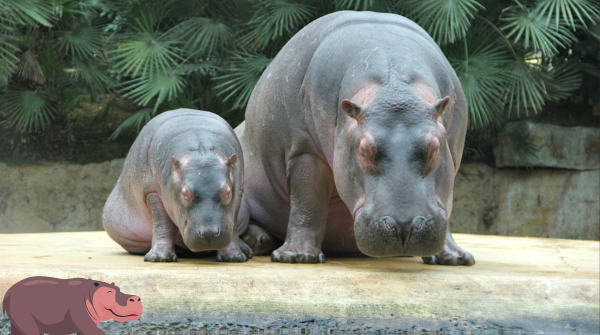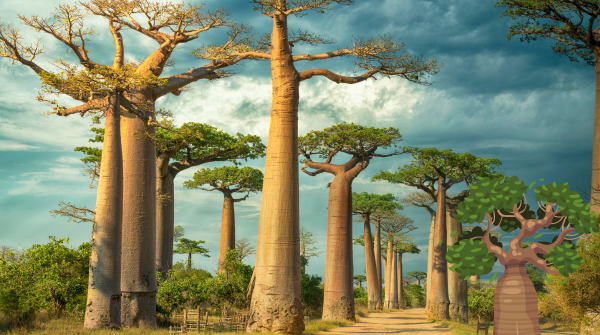Behemoths of the River: Exploring the Fascinating World of Hippopotamuses – By Bhanuka – eLanka In the realm of African rivers and lakes, few creatures command as much attention and awe as the mighty hippopotamus. With their massive size, formidable presence, and unique adaptations, hippos stand as iconic symbols of Africa’s waterways. In this article, we delve into the fascinating world of hippopotamuses, uncovering their behaviors, habitats, and the vital role they play in their ecosystems. The Physical Marvel of Hippos: Hippopotamuses, scientifically known as Hippopotamus amphibius, are among the largest land mammals on Earth, second only to elephants. Despite their hefty size—males can weigh up to 3,000 kilograms (6,600 pounds)—hippos are surprisingly agile in water, where they spend the majority of their time. Their barrel-shaped bodies are well-suited for aquatic life, with webbed toes, streamlined forms, and nostrils that can close underwater. Life in the Water: While hippos may ...
Bhanuka Nuwan
The Majestic Baobab: Unraveling the Mysteries of Nature’s Ancient Guardian – By Bhanuka – eLanka Standing tall amidst the savannah landscapes of Africa and beyond, the baobab tree commands attention with its imposing presence and timeless allure. In this unique article, we embark on a journey of discovery to explore the captivating world of the baobab—a majestic symbol of resilience, wisdom, and natural wonder. 1. An Ancient Legacy: The baobab tree, also known as the “Tree of Life,” has long been revered by indigenous cultures for its myriad uses and legendary longevity. With trunks that can span over 30 meters in circumference and lifespans that stretch for thousands of years, these iconic trees stand as silent witnesses to the passage of time and the ever-changing rhythms of the natural world. 2. Guardians of the Savanna: In the vast expanses of the African savanna, the baobab tree reigns supreme as a ...
Adventuring on a Budget: Money-Saving Hacks and Affordable Destinations – By Bhanuka – eLanka Traveling doesn’t have to break the bank! With careful planning and savvy strategies, adventurers can explore the world without draining their savings. In this article, we’ll uncover a treasure trove of money-saving hacks and affordable destinations for thrifty travelers looking to embark on unforgettable journeys without the hefty price tag. 1. Travel Off-Peak: Timing is everything when it comes to snagging the best deals on flights, accommodations, and attractions. Traveling during off-peak seasons, such as shoulder months or midweek, can result in significant savings on airfare and accommodation costs. Additionally, tourist attractions are often less crowded during these times, allowing for a more enjoyable and authentic travel experience. 2. Embrace Alternative Accommodations: While hotels can be luxurious, they often come with a hefty price tag. Thrifty adventurers can save money by exploring alternative accommodation options such ...
Education Technology: Empowering Learning in the 21st Century – By Bhanuka- eLanka In the rapidly evolving landscape of education, technology has emerged as a powerful catalyst for transformation. From interactive digital textbooks to immersive virtual classrooms, educational technology, or EdTech, is revolutionizing the way students learn and teachers teach in the 21st century. In this article, we explore the myriad ways in which EdTech is reshaping education, enhancing accessibility, engagement, and outcomes for learners worldwide. 1. Personalized Learning Experiences: One of the most significant benefits of EdTech is its ability to personalize learning experiences for students. Adaptive learning platforms use data analytics and artificial intelligence to assess each student’s strengths, weaknesses, and learning preferences, delivering tailored content and pacing to optimize comprehension and retention. 2. Interactive Multimedia Content: Gone are the days of static textbooks and chalkboard lectures. EdTech platforms offer interactive multimedia content, including videos, simulations, and gamified learning ...
Unlocking Efficiency and Innovation: The Power of Robotic Process Automation (RPA) – By Bhanuka – eLanka In today’s fast-paced digital landscape, organizations are constantly seeking innovative solutions to streamline operations, enhance productivity, and drive competitive advantage. Robotic Process Automation (RPA) has emerged as a transformative technology, offering the promise of automation and efficiency across a wide range of business processes. In this article, we explore the fundamentals of RPA, its benefits, applications, and the future outlook of this disruptive technology. Understanding Robotic Process Automation (RPA): Robotic Process Automation (RPA) refers to the use of software robots or “bots” to automate repetitive, rule-based tasks typically performed by humans. These software robots are designed to mimic human interactions with digital systems, such as navigating through user interfaces, entering data, and executing predefined actions. RPA solutions leverage technologies such as artificial intelligence (AI), machine learning, and natural language processing to automate workflows and ...
Unraveling Insights from Big Data for Better Decision Making – By Bhanuka- eLanka In today’s digital age, data has become the lifeblood of businesses across industries. With the exponential growth of data, organizations are increasingly turning to big data analytics to derive valuable insights that drive informed decision-making. In this article, we delve into the world of big data analytics, exploring its significance, methodologies, and the transformative impact it has on businesses. The Significance of Big Data Analytics: In a world inundated with data, the ability to extract actionable insights is paramount. Big data analytics offers the capability to process vast volumes of structured and unstructured data, uncovering patterns, trends, and correlations that traditional analytics methods may overlook. By harnessing the power of big data, organizations can gain a comprehensive understanding of their operations, customers, and market dynamics. Methodologies of Big Data Analytics: Big data analytics encompasses a diverse range ...
The Internet of Things (IoT): Enhancing Everyday Life with Connected Devices – By Bhanuka – eLanka The Internet of Things (IoT) has emerged as a groundbreaking technological revolution, seamlessly integrating the physical and digital worlds to enhance convenience, efficiency, and connectivity in our daily lives. In this article, we’ll delve into the transformative power of IoT, exploring how connected devices are revolutionizing various aspects of modern living. In today’s digital age, the Internet of Things (IoT) has become synonymous with innovation, connectivity, and efficiency. From smart homes and wearable devices to industrial automation and healthcare solutions, IoT technology is reshaping the way we interact with the world around us, offering endless possibilities for improving productivity, sustainability, and quality of life. At its core, IoT refers to the network of interconnected devices and sensors that collect, exchange, and analyze data to automate processes, monitor environments, and enable real-time decision-making. These devices, ...
Embracing the Future of Work: Remote Collaboration and Digital Nomadism – by Bhanuka – eLanka The landscape of work is evolving rapidly, driven by technological advancements and changing attitudes towards remote work. As more companies embrace flexible work arrangements, remote collaboration and digital nomadism are becoming increasingly prevalent. In this article, we’ll explore the future of work, highlighting the benefits of remote collaboration and the rise of digital nomads in today’s workforce. In today’s rapidly changing work environment, the traditional concept of the office is undergoing a profound transformation. With advancements in technology and a growing demand for flexibility, remote collaboration and digital nomadism are reshaping the way we work. Remote collaboration refers to the ability of individuals or teams to work together seamlessly from different locations. Whether they’re across the city or across the globe, modern technology enables employees to collaborate in real-time, share ideas, and complete projects without ...
Navigating the Future of Digital Security: Trends, Challenges, and Solutions – By Bhanuka – eLanka In an increasingly digitized world, the importance of robust digital security measures cannot be overstated. As technology continues to evolve at a rapid pace, so do the threats and challenges associated with cybersecurity. In this article, we will explore the future of digital security, examining emerging trends, evolving threats, and innovative solutions to safeguard digital assets and protect against cyberattacks. Evolving Threat Landscape: With the proliferation of connected devices, cloud computing, and the Internet of Things (IoT), the attack surface for cyber threats continues to expand. Cybercriminals are leveraging sophisticated techniques such as ransomware, phishing attacks, and zero-day exploits to target individuals, businesses, and critical infrastructure. The rise of artificial intelligence (AI) and machine learning (ML) has also introduced new challenges in cybersecurity, as threat actors utilize these technologies to automate attacks, evade detection, and ...
Green Technology Solutions: Addressing Environmental Challenges – By Bhanuka – eLanka In an era of increasing environmental concerns and climate change, the importance of adopting sustainable practices has never been greater. Green technology, also known as clean technology or eco-friendly technology, offers innovative solutions to mitigate environmental challenges while promoting economic growth and social well-being. In this article, we will explore the role of green technology in addressing pressing environmental issues and highlight some key solutions making a positive impact. 1. Renewable Energy Sources: One of the most prominent aspects of green technology is the utilization of renewable energy sources such as solar, wind, and hydroelectric power. These sources offer clean and sustainable alternatives to fossil fuels, reducing greenhouse gas emissions and dependence on finite resources. Solar panels harness the sun’s energy to generate electricity, while wind turbines convert wind power into renewable energy. Additionally, hydroelectric power plants harness the ...






